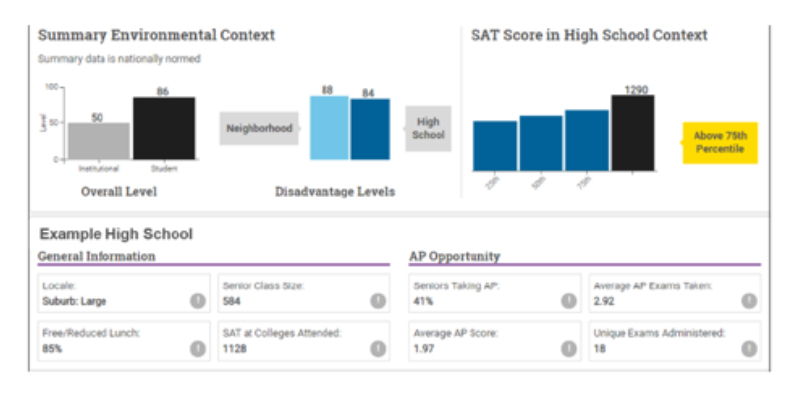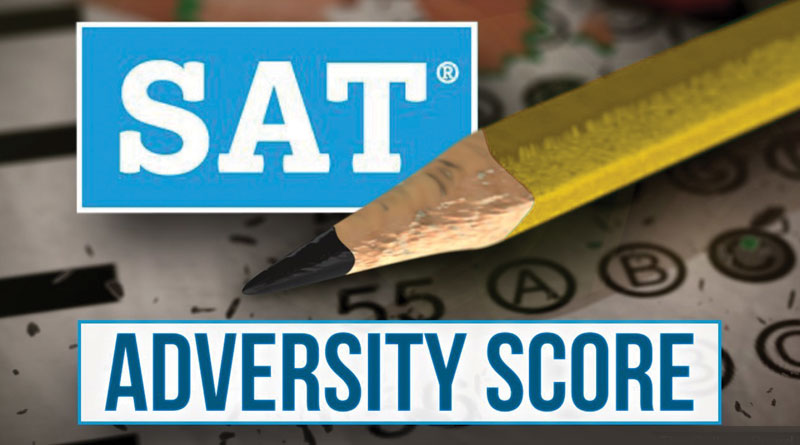SAT Exam Adds An Adversity Score.
By: Belinda Gonzalez-Leon, Ed. D., MBA
Premier Educational Consulting, LLC
Ph: (305) 494-9389
The Scholastic Aptitude Test (SAT), a test used by over 4000 colleges and universities in the United States as a major admissions factor, is adding an Adversity Score. The College Board, which developed and administers the SAT, has decided that in addition to scores on reading, writing, and math- they will now introduce a score that reflects the student’s socioeconomic status. According to The Wall Street Journal, the score range will be between 1 and 100 with 50 being the average score. The higher the student’s score, the greater the economic hardship the student is assumed to have undergone. The Adversity Score is actually part of the SAT’s new Environmental Context Dashboard which compares the student’s score to other students in their high school, neighborhood, and even nationwide.
How is the score determined? According to the electronic publication Education Dive, more than a dozen factors will be taken into consideration including crime rate of the student’s home area as well as poverty levels, percentage of rentals, and housing values. Also included is the student’s high school academic rigor, whether the student receives free or reduced lunch, the senior class size, availability of Advanced Placement (AP) courses at the high school, percentage of students at the school who attend college as well as the family’s income and stability. It will also factor in how likely it is for students in the area to enroll in a college that is considered “less-selective” when their grades and test scores suggest attendance at better universities. However, as per a CNN article, it will not take into account a student’s race. Many reviewers of the Adversity Score question how valid the score can be when it does not take into consideration a student’s race, but as Bart Grachan, Associate Dean for Progress & Completion Student Affairs of LaGuardia Community College which is part of the City University of New York, points out in Inside Higher Ed- including race would cause the tool to be illegal in several states so therefore not including it allows the tool available to all colleges.
Why did the College Board adopt this new Adversity Score? The intent behind the new score is to allow colleges and universities to weigh the different factors that would have affected the student’s ability to score well on the test. Colleges are trying to build a holistic picture of who the applicant is when determining admissions. An article in GoodCall indicated that in 2016, the American College Testing (ACT) website actually stated: “With more than 50 years of data to draw upon, ACT research suggests that for far too many individuals—often those from low-income, first-generation, or minority backgrounds—success along the K-career continuum is out of reach.”(The ACT is a similar test to the SAT and schools accept either or equally). The K-career continuum refers to the level of academic progression a student accomplishes between kindergarten and an actual career.
As reported in Inside Higher Ed, in the US there is a disproportionate number of low-income African American and Hispanic families that do not have access to quality public schools. Statistically, the student will probably not be able to attend a top quality school with a variety of AP courses; will not have the resources to take test preparation courses; and does not have a family with higher level education experience to pass on advice and guidance. This has led to a growing number of colleges to eliminate the SAT or ACT test requirement for admissions.
The Wall Street Journal reviewed data that showed that students whose parents are high-income and had completed college tended to do better on SAT exams. Typically, those students were identified as Asian or White and scored higher than their African-American and Hispanic counterparts. According to Education Dive, Florida State University (FSU) tried the Adversity Score as part of a pilot program and found that it allowed them to admit more African-American and Hispanic students. In fact, FSU reported to CNN that after using this new resource, “Nonwhite enrollment has jumped from 37% to 42% in the incoming freshman class” as per John Barnhill, Assistant Vice President for Academic Affairs. He went on to say, “You might see a student’s score and think, not bad but clearly below our university average. But then when you compare it to the school, it might be above the 75 percentile, which means they outperformed most people at their school. I believe this context is a more accurate reflection of what the score represents.” (Note: The state of Florida does not allow the race to be a factor in college admissions) Pace University, Georgia Institute of Technology, and the University of South California also found the score helpful while Yale and Duke University have also announced that they will start using the Adversity Score.
However, the College Board is also being criticized for this new initiative. According to a report from CNN, The National Center for Fair and Open Testing criticized the College Board for creating the score as an attempt to keep the SAT test relevant as more schools drop the SAT admissions requirement. Over 1000 colleges and universities do not use SAT scores as evidence continues to indicate that the scores are not reliable predictors of a student’s success in college. According to a 2016 University of Illinois study, college graduation rates can be better predicted based on a student’s grade point average (GPA) than their score on the SAT. In 2018, The National Association for College Admission Counseling conducted their own study where they reviewed over one million college applications and found that when a standardized test score requirement was not part of the college application process, the diversity of the incoming freshman class at universities increased.
Considering a current lawsuit with Harvard University regarding Affirmative Action policies, the College Board is also being accused of using the Adversity Sore as a pre-emptive move to assist colleges. Affirmative Action is a practice of considering race and ethnicity in admissions in order to promote diversity but if Affirmative Action is eliminated, the Adversity Score could be used as a tool to continue promoting a diverse student body. However, how each particular factor that goes into the Adversity Score is actually weighed is not being revealed. Is it being kept a secret to avoid abuse and manipulation of the score or is the College Board hiding a flawed formula that could also come under legal review?
In a Forbes article by Michael T. Nietzel, former president of Missouri State University, writes “The College Board has not revealed the factors or their weights in calculating adversity scores beyond claiming that some of the data are from public sources and some are proprietary. This is unacceptable. If it refuses to disclose how adversity scores are calculated, the College Board should not expect the public to accept them.” In addition to the formula, the score itself is not shared with students although the College Board did report to CNN that they are working on a way to make the information available to students in the future.
Marten Roorda, CEO of ACT, had strong words against the Adversity Score, as quoted from the ACT blog in Inside Higher Ed: “The algorithm and research behind this adversity score have not been published. It is basically a black box. Any composite score and any measurement, in general, requires transparency; students, teachers, and admissions officers have the right to know. Now we can’t review the validity and the fairness of the score. And even if that changes, there is also an issue with the reliability of the measure, since many of the 15 variables come from an unchecked source — for example, when they are self-reported by the student. The plan to report the adversity score only to the college is another example of not being transparent. If I were a student, I would become concerned or angry if the testing company would provide an adversity score to colleges without me knowing it, without me approving it, and without any of the end users understanding how this score is calculated.” Roorda goes on to insinuate that possible manipulation of the Adversity Score by students is possible – for example, submitting the address of a family or friend who lives in a low-income area in order to boost the score.
The College Board defends itself in the publication Inside Higher Ed where a spokeswoman states, “This is a tool designed for admission officers to view a student’s academic accomplishment in the context of where they live and learn. [The Environmental Context Dashboard] doesn’t provide information about the student. It provides information about the student’s environment. It puts a student’s SAT score and other academic accomplishments included in their college application in the context of where they live and learn.” The data, the College Board goes on to report, is produced from databases it maintains on high schools and the neighborhoods they are in as well as data on SAT averages and Advanced Placement enrollments and test scores (for example, is it the norm for students at this high school to take 5 AP courses). Data included is also pulled from U.S. Census and other public records (another reason to make sure everyone completes the U.S. Census!).
The decision of the College Board comes after two years of pilot tests were conducted by some 50 colleges last year and another 150 this year. Adversity scores will be available to all colleges by 2020. The colleges that tried the Adversity Score during the beta test reported to the College Board that it was helpful in understanding why students had low scores and some of the difficulties in obtaining a high score. According to the Chronicle of Higher Education, researcher Michael N. Bastedo, the University of Michigan at Ann Arbor, found that admissions officers were up to 28 percent more likely to admit a low-income applicant when they had a large body of information regarding the student’s high school. Other test colleges stated that because they have already developed a relationship with the high schools, they do not need to check an Adversity Score. Many colleges are familiar with the situations their future students have faced based on the high school they graduated from.
This is encouraging for minority students living in low-income areas, but how does it fair for African-American and Hispanic students living in high-income neighborhoods? That remains to be seen. One would assume that based on the Adversity Score factors, a majority of students in Doral, as well as several other affluent neighborhoods in Miami, will score low. This is a win for students who struggle to obtain quality high school education, but for those parents who worked hard to get out of poverty to afford their children a better education and upbringing- it would seem as if their sacrifices are working against them. There is grave concern over how the Adversity Score is actually determined and compared as well as the potential manipulation of factors to allow for students to increase their score. Perhaps the Adversity Score will be largely ignored by colleges as the SAT Essay has been? Regardless, the strong controversy continues to fuel the case for test-optional college admissions as well as the need for changing the overall structure of the test itself to be a more equitable measure of students across the board.
EXAMPLES OF HOW THE ADVERSITY SCORE IS PRESENTED:


